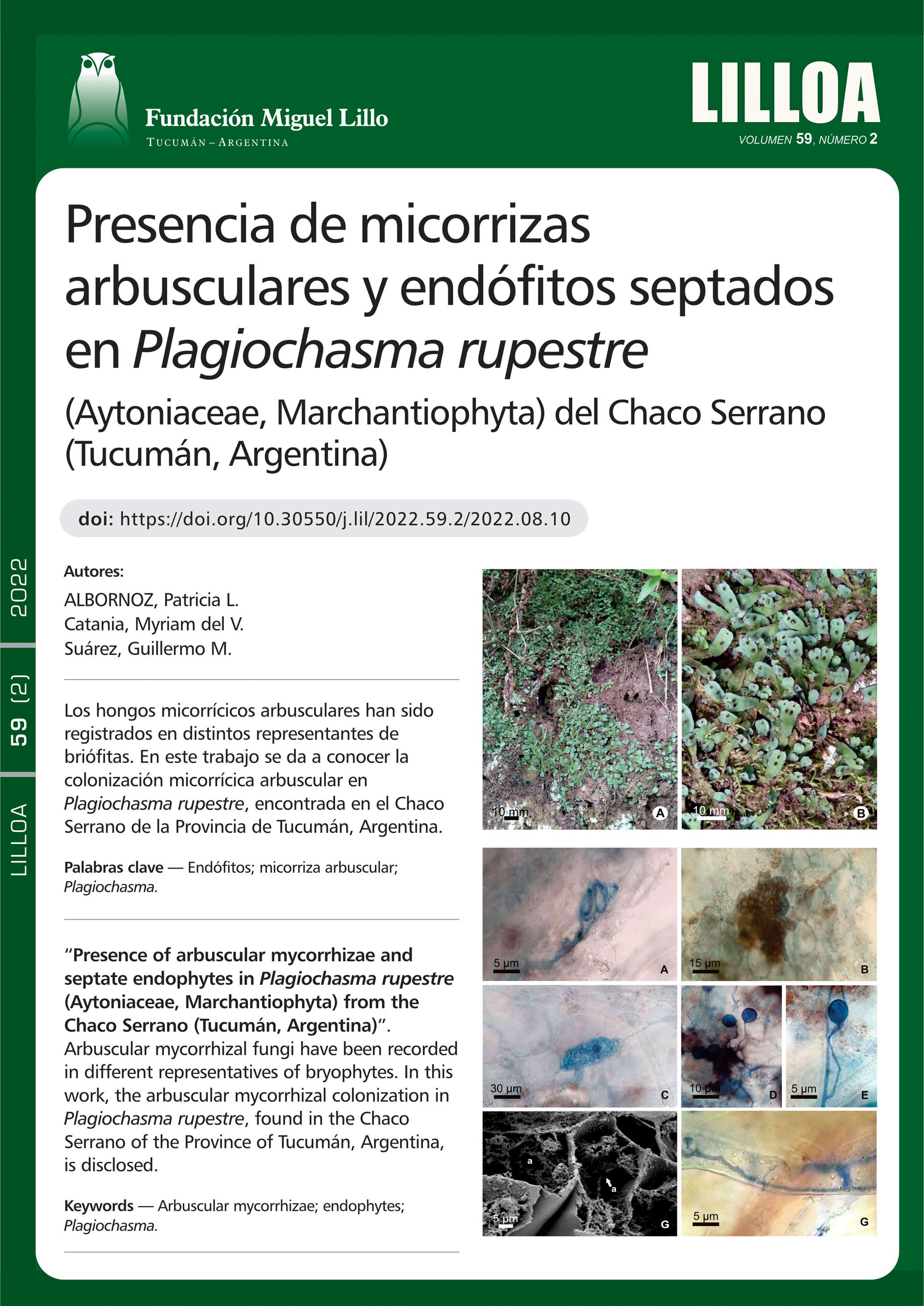Presence of arbuscular mycorrhizae and septate endophytes in Plagiochasma rupestre (Aytoniaceae, Marchantiophyta) from the Chaco Serrano (Tucumán, Argentina)
DOI:
Keywords:
arbuscular mycorrhizae, endophytes, PlagiochasmaAbstract
Arbuscular mycorrhizae fungi have been recorded in different representatives of bryophytes (sensu lato). In this work, the colonization in Plagiochasma rupestre found in the Chaco Serrano of Tucumán (Argentina) is disclosed. In addition, Arum and Paris morphological types and the co-occurrence with dark septate endophytes (DES) and unknown septate fungi (SUF) are described.
Downloads
References
A.B.De. (2017). Association of Glomus tenue (Greenall) Hall with the hepatic Mannia fragrans (Balb.) Frye & Clark. International Journal of Advanced Research in Biological Sciences 4 (8): 51-58. DOI: http://dx.doi.org/10.22192/ijarbs.2017.04.08.008
Azcón-Aguilar, C., Jaizme-Vega, M. C. y Calvet, C. (2002). The contribution of arbuscular mycorrhizal fungi to the control of soil-borne plant pathogens. In: Mycorrhizal technology in agriculture. S. Gianinazzi, H. Schüepp, J.M. Barea, & K. Haselwandter (Eds.), pp 187-197. Birkhäuser Verlag, Germany.
Bidartondo, M. I., Bruns, T. D., Weiss, M., Sérgio, C. y Read, D. J. (2003). Specialized cheating of the ectomycorrhizal symbiosis by an epiparasitic liverwort. Proceedings of the Royal Society B, 270: 835-842.
Bidartondo, M. I., Read, D. J., Trappe, J. M., Merckx, V., Ligrone, R. y Duckett, J. G. (2011). The dawn of symbiosis between plants and fungi. Biology Letters 7: 574-577. https://doi.org/10.1098/rsbl.2010.1203
Brundrett, M.C. (2002). Coevolution of roots and mycorrhizas of land plants. New Phytologist 154: 275-304.
Carafa, A., Duckett, J. G. y Ligrone, R. (2003) Subterranean gametophytic axes in the primitive liverwort Haplomitrium harbour a unique type of endophytic association with aseptate fungi. New Phytologist 160: 185-197. https://doi.org/10.1046/j.1469-8137.2003.00849.x
Chadha, N., Mishra, M., Prasad, R. y Varma, A. (2014). Root endophytic fungi: research update. Journal of Biology and Life Science 5: 135-158. https://doi.org/10.5296/jbls.v5i2.5960
Chambers, S. M., Williams, P. G., Seppelt, R. D. y Cairney, J. W. G. (1999). Molecular identification of Hymenoscyphus sp. from rhizoids of the leafy liverwort Cephaloziella exiliflora in Australia and Antarctica. Mycological Research 103: 286-288. https://doi.org/10.1017/S0953756298007217
Cottet, A. C. y Messuti, M. I. (2017). Identificación del tipo morfológico de micorriza arbuscular en Phaeoceros laevis (Anthocerotophyta). Boletín de la Sociedad Argentina de Botánica 52 (2): 291-293.
Cottet, A. C. y Messuti, M. I. (2019). New evidence about the interactions between liverworts in the genus Symphyogyna (Pallaviciniaceae) and arbuscular mycorrhizal fungi. Symbiosis 79 (2): 117-121. https://doi.org/10.1007/s13199-019-00634-2
Cottet, A. C. y Messuti, M. I. (2022). Nuevo registro de micorriza arbuscular en Asterella chilensis (Aytoniaceae, Marchantiophyta),
Patagonia, Argentina. Boletín de la Sociedad Argentina de Botánica 57 (1): 3-7. https://doi.org/10.31055/1851.2372.v57.n1.35364
Cottet, A. C., Scervino, J. M. y Messuti, M. I. (2018). An improved staining protocol for the assessment of arbuscular mycorrhizal in
bryophytes. Boletín de la Sociedad Argentina de Botánica 53 (2): 201-206. https://doi.org/10.31055/1851.2372.v53.n2.20577
D’ Ambrogio de Argüeso, A. (1986). Manual de técnicas de histología vegetal. Editora Hemisferio Sur, Buenos Aires, 83 pp.
Dickson, S. (2004). The Arum-Paris continuum of mycorrhizal symbioses. New Phytologist 163 (1): 187-200. https://doi.org/10.1111/j.1469-8137.2004.01095.x
Estébanez, B., Draper, I. y Díaz de Atauri, R. (2011). Briófitos: una aproximación a las plantas terrestres más sencillas. Memorias de la Real Sociedad Española de Historia Natural 9: 19-73.
Field, K. J., Rimington, W. R., Bidartondo, M. I., Allison, K. E., Beerling, D. J., Cameron, D. D., Duckett, J. G., Leake, J. R. y Pressel, S. (2015). First evidence of mutualism between ancient plant lineages (Haplomitriopsida liverworts) and Mucoromycotina fungi and its response to simulated Palaeozoic changes in atmospheric CO2. New Phytologist 205: 743-756. https://doi.org/10.1111/nph.13024
Fonseca, H. M. A. C. y Berbara, R. L. L. (2008). Does Lunularia cruciata form symbiotic relationships with either Glomus proliferum or G. intraradices?. Mycological Research 112:1063-1068.
Karnovsky, M. J. (1965). A formaldehyde glutaraldehyde fixative of high osmolality for use in electron microscopy. Journal of Cell Biology 27: 137-138.
Ligrone, R., Carafa, A. Lumini, E., Bianciotto, V., Bonfante, P. y Duckett, J. G. (2007). Glomeromycotean associations in liverworts: A molecular cellular and taxonomic analysis. American Journal of Botany 94 (11): 1756-1777.
Pozo, M. J., Cordier, C., Dumas-Gaudot, E., Gianinazzi, S., Barea, J. M. y Azcon-Aguilar, C. (2002). Localized versus systemic effect of arbuscular mycorrhizal fungi on defense response to Phytophtora infection in tomato plants. Journal of Experimental Botany 53: 525-
Pressel, S., Bidartondo, M. I., Ligrone, R. y Duckett, J. G. (2010). Fungal symbioses in bryophytes: new insights in the twenty first century. Phytotaxa 9: 238-253.
Rabatin, S. C. (1980). The occurrence of the vesiculararbuscular mycorrhizal fungus Glomus tenuis with moss. Mycologia 72: 191-195.
Read, D. J., Duckett, J. G., Francis, R., Ligrone, R. y Russell, A. (2000). Symbiotic fungal associations in ‘‘lower’’ land plants. Philosophical Transactions of the Royal Sciences 355: 815-831. DOI: https://doi.org/10.1098/rstb.2000.0617
Rimington, W. R., Pressel, S., Duckett, J. G., Field, K. J., Read, D. J. y Bidartondo, M. I. (2018). Ancient plants with ancient fungi: liverworts
associate with early-diverging arbuscular mycorrhizal fungi. Proceedings of the Royal Society B 285: 20181600.
http://dx.doi.org/10.1098/rspb.2018.1600
Scagel, R. F., Bandoni, R. J., Maze, R. J., Rouse, G. E., Shoefield, W. B. y Stein, J. R. (1982). Nonvascular Plants. Wadsworth Publ. Co., Belmont, Cal., USA.
Schenck, N. C. y Pérez, Y. (1990). Manual for the identification of vesicular–arbuscular mycorrhizal fungi. INVAM, University of Florida, Gainesville.
Schüßler, A., Schwarzott, D. y Walker, C. (2001). A new fungal phylum, the Glomeromycota: phylogeny and evolution. Mycological Research 105: 1413-1421.
Silvani, V. A., Rothen, C. P., Rodríguez, M. A., Godeas, A. y Fracchia, S. (2012). The thalloid liverwort Plagiochasma rupestre supports arbuscular mycorrhiza-like symbiosis in vitro. World Journal of Microbiology and Biotechnology 28: 3393-3397. DOI 10.1007/s11274-012-1146-7
Smith, F. A. y Smith, S. E. (1997). Structural diversity in (vesicular)-arbuscular mycorrhizal symbioses. New Phytologist 137 (3): 373-388. DOI: https://doi.org/10.1046/j.1469-8137.1997.00848.x
Zhang, Y. y Guo, L. D. (2007). Arbuscular mycorrhizal structure and fungi associated with mosses. Mycorrhiza 17: 319-325. DOI 10.1007/s00572-007-0107-8
Published
How to Cite
Issue
Section
License
Copyright (c) 1900 Lilloa

This work is licensed under a Creative Commons Attribution-NonCommercial-NoDerivatives 4.0 International License.









